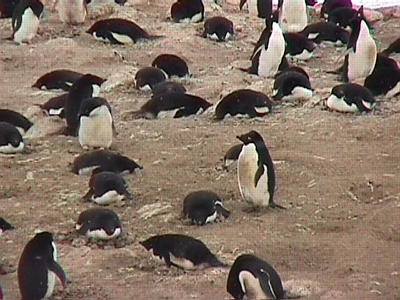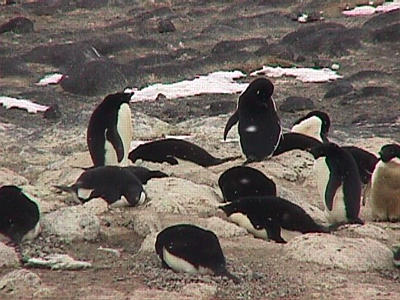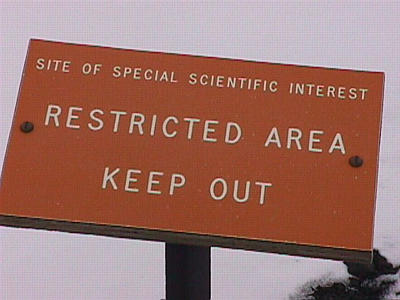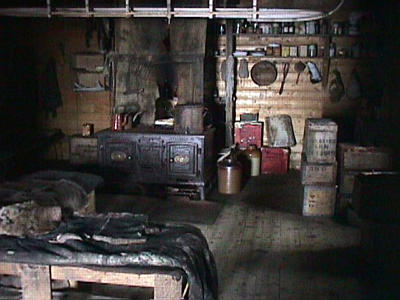
|
|
27 November, 1998
Friday, November 27th, 1998
Hi! Today was another one of those FABULOUS days here in Antarctica. Thanks
to the members of the "Upstream Delta" remote field crew, who are stuck here
in McMurdo. When the Hercules airplane slid its runner into a crevasse
recently, the pilot was in the process of locating a site for the remote
runway that would be used to fly in equipment and members of the Upstream "D"
(or Delta) team. Unfortunately, this is a very tricky business and as the
pilot was doing "ski drags" checking out the area, they got stuck in a
crevasse. I know how hard it can be to spot cracks in the sea ice, until you
are directly upon them, so I wouldn't have wanted to be in their position.
The men and women who work in Antarctica often face challenges much different
than those faced by people working in other remote areas of the world.
Anyway….back to the team of Upstream Delta….thanks to Hermann, Barclay, Beth,
Ben, Greg, Hans, Matt, Shul, and Ginny for including me in such a FANTASTIC
day! Yes folks, I FINALLY got to see PENGUINS (and other things!). I even
made it to breakfast in the galley this morning. I haven't been going to
breakfast since I work very late and tend to sleep in a bit. I met with the
Upstream "D" team at around 7:00 AM and by 8:00 AM some of us were down at the
snowmobiles getting ready to go, while other members of the team were off
getting 2 Sprytes and survival bags. Nancy, (from search and rescue
and field training) drove one Spryte and Hermann, the other. There were 3
snowmobiles in addition to the Sprytes, which carried 2 people each. I rode
in a Spryte to start with and met Linda, who is a janitor here is McMurdo…she
called herself a "flushologist" to sound scientific. Her husband is head of
the galley, so they get to come down here and work during the summer season.
It would be nice to have MY husband here working in McMurdo! I'm really
missing home with the holiday and all!
Since the snowmobiles are so much faster than the Sprytes, the drivers/riders
would zip ahead of us, then stop to take photos, play in the snow, or just
look at the scenery, and the Sprytes would have to catch up. Sometimes the
snowmobiles would go back and forth on the flagged route, between the Sprytes
and a point farther ahead. We took the same route as I have three previous
times….towards Cape Evans (where Robert Scott's hut is located). Our
destination was Cape Royds…penguins and Ernest Shackelton's "Nimrod"
expedition hut. This path has become quite familiar to me, since I've ridden
out that way on snowmobiles twice before. Right about at Big Razorback
(remember the seal scientists?) the Sprytes stopped for a few minutes and
people switched around from Spryte to snowmobile. From that point on during
the day, I rode on the back of, or drove, a snowmobile. The feeling of cold,
fresh air on my face and the warmth of the sun at the same time, makes being
outside feel GREAT to me. This was also the first time (since I've been in
Antarctica), I'd been on a snowmobile with another person driving it, and that
was really kind of relaxing.
Now and then we'd stop and take photos, but we pushed on toward Cape Royds.
After we passed by Cape Evans, the flags on the route got farther and farther
apart. Cracks in the sea ice became more visible and we had to be very
careful when driving the snowmobiles over each one. You have to cross the
cracks like crossing the letter "t", perpendicular, not parallel to these
cracks. The Barnes Glacier, a huge and magnificent sight, was on our right
hand side for quite awhile. It's height was comparable to some of the
icebergs we saw at Cape Roberts…it's blue tint so typical of glacier ice. We
decided that we would explore this area further on our return trip.
Lone seals were lounging on the ice near the flagged route. They just don't
seem that bothered by the noisy snowmobiles as they pass by. Now and then one
might lift its head, but they plop back down again after a quick look. We did
see one seal that began to move, we thought, out of nervousness. It turned
out that it was on the move to a different location, and as we stood and
watched, it slid on the ice and crossed directly in front of the Sprytes. Not
too long after that, while we were flying along the trail…my first two
penguins came into view. How exciting! I couldn't believe I was finally
seeing them! The pair was waddling along out in the middle of nowhere, and
one began to slide on its belly across the ice. I couldn't wait to get to
Cape Royds!
At long last we reached the end of the flagged trail, at the foot of a rocky
hill, covered in most areas with a blanket of snow and ice. After parking all
of our vehicles, we set off on foot to climb the hill and walk down the other
side toward Shackelton's hut. Nancy opened the hut up immediately (you have
to check out a key from the NSF Chalet, and only 8 people at a time can be
inside the hut), but everyone seemed to gravitate toward the penguin rookery.
A rookery is an area where the penguins congregate or gather together. This
is THE most southerly recorded penguin rookery in the world…and it is said
that it is filled with 3,500 pairs of Adelie penguins. I walked toward the
edge of the protected area to get a closer look.
Signs were posted to mark the boundary of where people could approach the
penguin rookery. These specially protected areas have boundaries that are
strictly enforced. It is for the well-being of the animals in the area. Many
of these Adelies were nesting at the moment. With the telephoto lens on my
camera, it was almost like having good binoculars. I could see penguins
sitting on their eggs and the eggs underneath them (by their feet). I sat and
watched penguins waddle, slide, flap their wings, crouch down, and move about
the rookery. There seemed to be thousands of them although I'm not sure what
the exact count is at the present time. The smell of penguin "scat" was bad
at times, but not as overwhelming as I had expected. The noise was quite a
cacophony of sounds…and very loud at times. There was a lot of squawking
going on in the colony.
Eventually I made my way to Shackelton's hut…which was of great interest to
me. Comparing it to Robert Scott's hut at Cape Evans, it was much more
"rustic" and primitive. Ernest Shackelton built this hut in February of 1908.
The hut was not divided into sections for officers and regular enlisted men,
although Shackelton did have a small private room in the hut. Fifteen men
lived in this hut, and all of them left here alive, unlike the men of Scott's
"Terra Nova" expedition. It has the same musty smell and faint hint of light
coming through he door and window coverings that Scott's hut does. There are
supplies left on the shelves and I got a similar feeling of eeriness, being in
a place that was erected so long ago, to support such adventurous spirits as
Ernest Shackelton! There were socks hanging on a line, a box labeled "1907
British Antarctic Expedition," tools, a huge iron stove with kettles still on
it, wooden sleds hanging from wrought iron hooks nailed into the ceiling, and
the old wooden bed frames-some with blankets and furs still strewn over them.
The food stores, although limited in comparison to Scott's hut, were still
rather abundant. Inside I saw bottles of gooseberries, plums, and red
currants. There were jars of table salt, tins of cocoa, corn flour, hops, and
bottles of pickles. I also found a box of wholemeal biscuits…still open with
biscuits just sitting there in the open box. Some of the same types of food
products that I found at Scott's hut at Cape Evans, lined the shelves in
Shackelton's hut here at Cape Royds…veal and ham, herring in tomato sauce,
haddock, and a new item…concentrated egg powder. Yum!
The supply of medicine was quite small…some bandages and small amounts of
bottled goods. There was a bottle marked "Dysentery" and another labeled
"Jeye's Disinfectants" (made in London). A picture of King Edward VII and
Queen Alexandra hung on the wall of the hut. I read in one of my guide books
that the dining room table used to be lifted up from the floor each night,
which helped save space in the hut. It's gone now, and historians think that
it could have been used by a later party that ran out of fuel.
I ran into Gary Wilson at the hut…he was with another group of people
venturing out to Cape Royds today. He had ridden out on the back of a sled
(like those used by mushers, pulled by sled dogs). I have a photo to show you
later. This group was entirely moving about by Skidoo, so they had left
McMurdo after us, and eventually arrived back before us. We did take several
extra stops along the way, which also put us behind them. There are limits as
to how many people can be at Cape Royds at one time….not just in the hut. You
won't see swarms of people in one place like we do at home. Visitation is
strictly regulated in many special locations in Antarctica.
After I was through in the hut, I walked to the other side of the penguin
rookery. Adelies are so cute. They are purely black and white, with a very
distinct white eye ring. The females tend to be a little bit smaller. The
Adelie penguins feed mainly on Antarctic and ice krill. These penguins can
dive deep, but dives tend to be shallower. Adelie penguins are well-studied
and many colonies (usually those away from human disturbance) have grown in
number. This species is not in danger. We did have one stray penguin waddle
toward us…I hope those slides turn out! Also, I found part of a penguin egg
shell on the ground and noticed that the shell was quite thick. Skuas (the
large gull-like birds that I've seen around MacTown) were circling overhead
and they will prey on penguins, although they also eat krill. It was a BUSY
place!
We spent a couple of hours around Cape Royds and at about 1:45 PM I hiked back
to the snowmobiles and Sprytes to sit and have my lunch. The galley had
prepared sack lunches for us, and I was hungry….breakfast had been awhile ago!
Eventually all of the members of our group wandered back to the parking area,
and before long we were packing up to leave. Lucky for us, we weren't headed
directly back to McMurdo. We had several stops left on this journey. Nancy
needed to drill some holes in the cracks of the sea ice to make some
measurements (for a safety check). She stopped her Spryte across from the
Barnes Glacier, which meant we had time to hike over the foot of the glacier
and get a closer look. What an incredible, massive, chunk of ice. All of us
took tons of photos here! I wonder how many "ice" photos I'll have when I get
back home. It's just too tempting when I see all of this beauty, NOT to take
oodles of photographs.
Back on the snowmobiles, it was a short ride over to Cape Evans….I got to
visit Robert Scott's hut ONE MORE TIME! To think that I was worried that I
might not get there at all, and now I was on my third visit. This was too
much! I re-visited some of my favorite spots in the hut, but also checked out
some new corners….the darkroom, with its supply of developing equipment, was
of parcticular interest. I also took time to really study the medical
supplies….bandages still neatly rolled up, and bottle upon bottle of pills and
elixirs ready and waiting for a reason to be opened. When I walked across the
hut to the bunks, I noticed spikes on the bottoms of a pair of shoes that were
hanging on the bed post. They looked a lot like the spikes that runners in a
track meet would wear. I'm sure that these helped the men grip on the ice.
Our next destination was the ice caves…on the tongue of the Erebus Glacier.
This time I started with the smaller cave, since I didn't get a chance to go
into that one when I visited the ice caves before. It was definitely a one
person cave…very narrow opening, but a tall ceiling above me….loaded with
exquisite ice crystals! I didn't spend a long time in this cave, since others
needed to have a turn…I went on to the larger cave and crawled down the metal
ladder to reach the bottom. I explored a section which I didn't get to last
time…and found some new crystals and formations. I love re-visiting these
places, because I notice new things each time I do!
That was our last stop, and I enjoyed barreling toward McMurdo on our Tundra
II snowmobile. Although these are smaller than the Skidoos that I've been
riding on, they were faster and had lots of zip! The ride back to McMurdo was
TONS of fun! By the time we got back, it was nearly the end of dinner time.
Since we have no restaurants in town….it's either make dinner or go til mid-
rats (midnight rations). All of us wanted to get to dinner. We caught a ride
up toward the galley in the Sprytes, and retrieved our orange duffles at the
Search and Rescue building after dinner.
There was a huge party at the MEC building…where they repair and service
snowmobiles and other small machines. It seems like every weekend some group
around McMurdo is having a party. There was even a band playing at this one!
There are actually several bands in town, lots of people with instruments and
even some choral groups. Something for everyone! I was sun and wind burned
from my long day outdoors, and totally exhausted. Another LONG day for me…but
a SUPER one!
Before I close, I wanted to explain a little bit about the project the team of
Upstream Delta is going to work on. Once they get to their remote field camp
(about a month later than expected because of the Herc stuck out there!), they
will be drilling through the ice stream to see how much it moves. They check
out what's underneath the ice stream and examine the fast moving ice. This
ice can move 1 meter per day! There are 9 people on this team….from all over
the country and Shul is from London, England. These scientists are all
glaciologists or have experience in glaciology. A really great group to spend
a day with!
Talk to you tomorrow!
Betty :)




Finally, I can show you penguin photos that I took myself!

These signs marked the boundary of the area protected for the penguin rookery.

I'll have more photos of Shackelton's "Nimrod" expedition hut with tomorrow's journal...as well as more photos from our Cape Royds adventure!

This may be a little dark, but I hope it gives you some idea of how the hut looked inside.
Contact the TEA in the field at
.
If you cannot connect through your browser, copy the
TEA's e-mail address in the "To:" line of
your favorite e-mail package.
|
